
|   |

|   |
 e-mail: leelakaverivenkat@gmail.com Living movements serenade frozen movements in Konark Photos courtesy: Odisha Tourism December 13, 2017 The crackling air of excitement all round the Konark township during the annual festival mounted jointly by the OTDC and Odisha SNA, would seem to show that far from evoking ennui, this event, over the years, is attracting larger audiences from all over. What with the Sand Art exhibition on Chandrabhaga beach involving voluntary participation from several foreign artists, a day time literary festival, the grand temple site with Puri also just an hour away by road and handloom exhibition, this week long fare projects a mini art world of Odisha. The Pipli lamps, road strewn with rangoli patterns, trees and plants lit up in myriad colours, and guest houses decorated with exotic lighting, add to the atmospherics. And every year sees something new - this time the nifty drone camera taking pictures for simultaneous DD Bharati broadcast replaces the intrusive long armed Doordarshan contraption which used to obstruct view in earlier years. The festival fare devoted one half of each evening to an Odissi group presentation, with a non-Odissi projection in the other half - all watched by a handsome turnout in the massive open air auditorium. Manmath Sambhav was the opening event by Nupur Dance Company by Niranjan Rout and group. Conceived by Nabakishor Misra whose libretto had music composition by Ramahari Das with Dhaneswar Swain contributing the rhythmic component, Niranjan Rout was the dance choreographer. Roopak Kumar Parida's vocal support with Sachhidananda Das' mardal provided the most sur-filled musical tones to start with - the complete tonic alignment in every percussion sound falling like manna to the ears - starting with the chanting like prayer to Shiva, much in the Odissi Chando pattern, followed by Shankarabharanam. But towards the latter half, music seemed to lose its tonic, with the female singer's He Jagadeeshwara very flat. The dance presentation relied for effect on the better male dancers who as Tarakaasura, Shiva and even Manmatha were convincing. Full of a powerful physicality in the dance visualisation, were the scenes of the high and mighty stride of a Tarakaasura or even Manmatha firing his pancha bana flowered darts (in raga Vasanth) trying to awaken the meditating Shiva (Jago Jago in Bageshwari), with Shiva's wakeful state eyeing Parvati with desire overcoming him, till wondering about a meditating Yogi falling into the trap of sringar he discovers the trick played by Manmatha and in seething anger the power of his third eye reduces the Love God to cinders. The dance composition seemed so weighted to suit masterful masculinity that not even in the Pallavi Tarijhum jhum Tarijhum did one experience that lavanya or sensuous grace, which is the hallmark of Odissi. The move of girls becoming the flames engulfing Manmatha was well conceived. But as the Bhairavi Moksha came at the end, one wondered about the kind of road Odissi was taking. And the costumes with Shiva in a garish red and blue could have been more subdued. 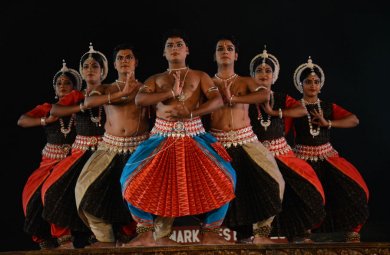 Nupur Dance Company 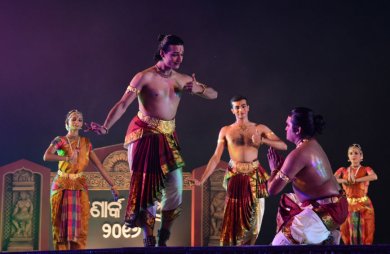 Temple of Fine Arts, Malaysia With 12 centres functioning in six countries, Malaysia's Temple of Fine Arts in Kuala Lumpur presented Bharatanatyam and the standard of the dancers trained under Shankar Kandasamy, was impressive, to say the least. Trim taut bodied dancers moved with finish, rendering the wise choice of Swati Tirunal's Bhavayani Raghuramam. Composed in the ragamalika format, the dance narrative built round the Ramayana epic easily communicated to the audience. Neat scenes without superfluous padding, with electric teermanams in different rhythmic gaits, linking up the episodic treatment, fetched the dancing warm applause from a discerning audience. The fly in the ointment was during the second half when the singing seemed to go off sruti. And this malady in the second half with instruments losing their tonic in the cold air and voices going haywire with the sound feedback creating confusion, was, for some reason, more or less, a feature of the five days. After Nattai, Natakruranji, Dhanyasi Mohanam being well sung, the latter half suffered with even the ending Madhyamawati not in tune. Pity because the dancers were flawless. Kathak by Nirupama Rajendra and Abhinava Dance Company from Bengaluru, in the opening Laya Laasya number where nritta through rhythm and bodily attitudes (helped by excellent parhant by Shivraj Natraj), communicated both the graceful and the forceful tones, creating a tremendous impact. Characterised by tasteful costumes, painstakingly trained dancers, immaculate footwork and performance space covered in neat formations, the worshipful mood of a Gham gham Ganapati was followed by the softly sensuous eye movements in a gator chali or movement reminiscent of a flight of birds with light footed chakkars and jumps, with the music scored by Praveen Rao changing from Hamsadhwani to Yamuna Kalyani. Rasalila, given a Gujarati aroma in costumes, showing Krishna after his Gopi ched- chad doing the disappearing act to teach the Gopis a lesson about giving up pride - and joining them only after even Radha has atoned, ended on a sublime note, which could have provided a perfect finish to the programme with music ending in Bhairavi after the Kalawati, Desh, Piloo. After this came the gap while the usual sound problems had to be tackled before Chaturang in Khamaj with Sahithya, Sargam, Bols and Tarana with the text built round the dance of Shiva and Parvathi was performed with aplomb with a tatkar, ending with claps where the audience was cleverly drawn into participation. What one appreciated in the programme was different talas of 12 matras, 14 matras and 16 matras being executed with finesse. The wrong move lay in Nirupama's stage appearance with a hand mike apologising to the audience for time taken to set right the sound balancing. Dancers need to be cautious about what is voiced during a simultaneous Doordarshan coverage, for the camera was capably covering gaps in stage action with interesting scenes from the great temple, the sea, the sand etc. Announcing a drawback in facilities, heard by all DD Bharati viewers, was embarrassing for the organisers and could have been avoided. 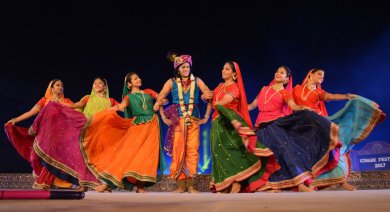 Abhinava Dance Company 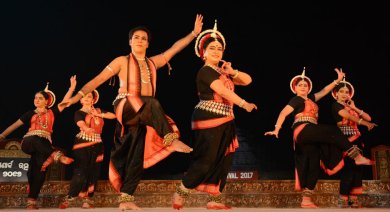 Deeksha Manjari Journey to Odissi presented by Kolkata's Odissi dancer Dona Ganguly's Deeksha Manjari had nothing spectacular or very original to offer, being based on compositions choreographed by her late Guru Kelucharan Mohapatra. The heartening feature, however, in the Arabhi Pallavi performed by the group (choreography was by Ratikant Mohapatra who was on the pakhawaj) was that there was no deviant dancing and all the performers moved correctly. Rupak Parida provided the vocal support. During the presentation of Ardhanariswar, sound again ran into problems and of all persons, violin by a reputed musician like Agnimitra Behera sounded totally off tune, in rendering the score created by the late Raghunath Panigrahi. By far the most disciplined Odissi presentation came from Ramli Ibrahim's Sutra Dance Theatre from Malaysia in 'Ganjam', though his innovative approach has many critics in Odisha. Original dance composition by Gajendra Panda with group choreography and artistic direction by Ramli Ibrahim, were founded on concept of the literary and visual consultant, late Dinanath Pathy. Reflecting the flavours of Sakhi Nata, Prahlad Natak, Daskathia, Nagarakirtana and Shakti worship of South Odisha namely Ganjam, the suite of items conceived on a complete Odissi margam format of Mangalacharan, Sthai, abhinaya through Rama Bhajana and Yogini Moksha had dancers who had been obviously rehearsed to the nth degree - so flawless was the group, in the constantly changing formations, with the confidently performing little ten year old in front, an absolute sight for sore eyes. The earthy verve of folk dance adapted to the stylised strength of Odissi chimed in well with the Tridhara style of Ramli's Guru late Debaprasad Das with his sabda swara patha approach. The aesthetic costuming, the colourful processions, flashing of banners done without a glitch in movement, the bodily deflections and rhythmic exactitude which did not falter even in the breakneck speed of the Yogini Moksha sequence, here was one group which managed its music set by Gopinath Panda (rendered by Satyabrata and Sangita Panda) without pitfalls, even while female singer Sangita Panda's voice showed strain towards the end. Having seen the production in Malaysia, it was interesting to see how the choreography had been totally altered to suit the very different performance space of Konark. 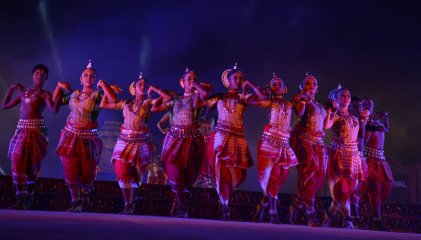 Sutra Dance Theatre 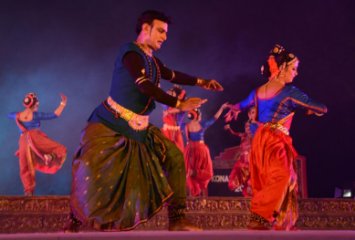 Rasa United Kuchipudi of Rasa United led by dancer/choreographer Vanashree Rao started with verve with Ananda Tandavam in Keervani, the group visualisation of late Vempati Chinna Satyam's original dance visualisation. Bharatanatyam Guru/dancer/music composer Vasudevan was the solo dancer in Bharatanatyam with the interacting female group in Kuchipudi. K.Venkateshwaran's singing was fine in the first half. But then, by late evening the usual balancing confusion started and one musician could not hear what the others were performing and the music became confused - quite unlike this group's performances, which are known for their music accompaniment - both composing and rendering. The Kuchipudi girls were very graceful and the nattuvangam by Kesavan had punch. Still the Mahishasura Mardini piece got overstretched in repeating overlong one line of the devi's destruction of the asuras, with tempo lost and message diluted. Tillana with the elements of Pancha tatwa could not be gauged in the right perspective with the music losing its disciplined tone. Having witnessed earlier performances, I can say that the full potential of this group was not realised. Next evening's Manipuri Nartanalaya's presentation led by Bimbavati Devi, very different from the rest, was like a breath of fresh air. The start with Kathkchaba with Kalawati Devi's music in Bhopali showing the bhangis of Krishna in the dance was, in its serene grace, an example of beauty with Bimbavati even as a solo dancer of such a gentle dance form able to hold audience attention on that vast stage. Guru Bipin Singh's Tanum, the Tarana showing Saajat, the animal gaits (deer, birds, tiger) in the dance movements reminiscent of Thang Ta technique set to rupak tal, was replete with the group's light-footed elegance, even in the tandav movements. With music composed by Srijan Chatterjee, Mahashakti reflecting the energy and power of Goddess Jagaddhatri, again by Bimbavati Devi, had soulful music, the yodelling and emotive voice-breaks, very Manipuri. Vasanta showed rasadhari Krishna with scenes from holi in Manipur, the dance, a reworked version of Kalawati's original choreography with Dhol Cholom, Khartal Cholom and Khubak Ishei glimpses and the ashtapadi Lalita lavanga lata in a scene. Bipin Singh's Jaya Jaya Deva Hare during the Rath Jatra with the reworked Gopi Viraha scene as Gopis mourn Krishna's departure as he gets ready to leave for Mathura was another well performed scene. 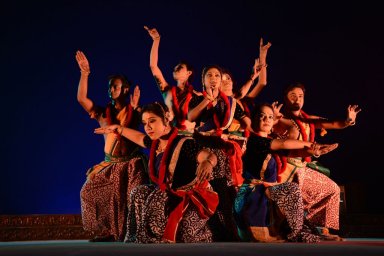 Manipuri Nartanalaya 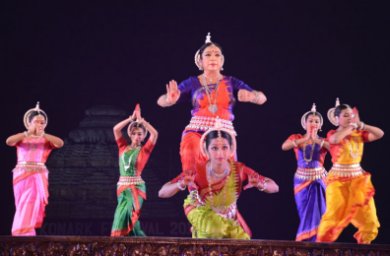 Kaishiki Navagraha Worship by Daksha Mashruwala and group from Kaishiki, Mumbai, with homage offered to Surya, Chandra, Mangal, Shukra, Shani, Rahu, Ketu, Brihaspati and Budha offered known fare but must be thanked for keeping Kelucharan Mohapatra's items as composed by the great master. Both the Khamaj Pallavi and the Oriya song by Salebeg 'Ahe Neela Sahilo' were rendered by correct if not exceptional or brilliant talent. Vasanta visualised on the textual format of verses from Kalidasa with music set in a Ragamalika form saw some animated dancing. The music was excellent with Jatin Sahu's vocal and fine mardal whose tone with the ukkuta recitation were typical of Bengaluru's Nrityagram mode, with the percussionist having worked with Nrityagram for a long time. This was one group which even taking the floor in the second half, had no besura problems with the music. Nalanda Dance Research Centre, the brainchild of veteran artist Kanak Rele, which gained the name of being a top institution for its Mohiniattam faculty, was disappointing in the fare offered, the torso andolika with controlled energy where movement in coils as it were churns out absolute enchantment, missing in the performers. So too were the neck movements and abundant lasya of this style of dance. Are the performers putting in less effort? Without this quality, mere correctness of rhythm in Mohiniattam accomplishes little. Ritu Duruva on the seasons, set on verses from the Natya Shastra and Kalidasa's Ritu Samhara, was followed by ashtapadi Chandana charchita, where the role of Krishna, in all the prankish behaviour set to Mohanam, one felt called for some artistic subtlety. The formations, while neat, showed no originality. The performance concluded with Jeeva, late Kavalam N.Paniker's music composition with dance visualising final release or mukti or meditation through the movement. The experienced crew for music with M.S. Gireesha's vocal support and Edakka (Nambisan), Dakshinamurthy (mridangam) was in full control and seemed to encounter no problems of sruti or sound. The dancing while correct was, for this critic, not the unforgettable performances experienced from the same institution in bygone years. 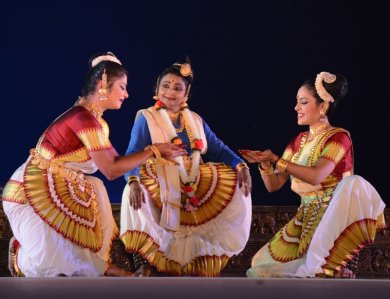 Nalanda Dance Research Centre 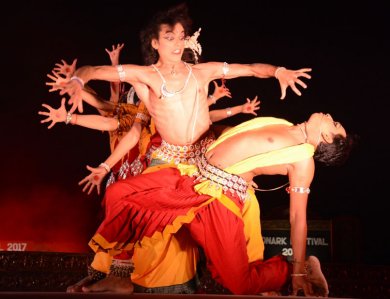 Odissi Research Centre Odissi Research Centre, playing host put itself last and its theme of the 6 evils of Kama, Krodha, Lobha, Matsarya, Moha and Ahamkara illustrated through episodes from mythology, had the right foundational crew of theme suggested by Aruna Mohanty and Sangita Gosain, with the script authored by scholar Pt Nityananda Misra, and music composed by Swapneswar Chakrabarti. Kasturi Patnaik's dance choreography rendered by neat dancers started off very well, later falling into the trap of overdoing the natya element - making the presentation more like Geeti Natya than pure Odissi in which the danced element needed more emphasis. True, that incidents like Kaikeyi's love for her son (Putra moha and rajya moha), or Duryodhana's greed and jealousy (matsarya) or Ravana's arrogance (ahamkar) which resulted in his losing all he had, are too etched in popular cultural memory, becoming liable to be overblown in a work. Some scenes tended to be too long while some others were clipped and to the point. Starting with a montage of formations representing all the evils, the opening sequence showed clean dancing. The dancers moving to music in Tilang in the episode on Ravana's ahamkar with the khandajati Rama-Ravana encounter were well done. But in the scene showing the Pandava Palace in Indraprastha with Duryodhana and Shakuni fooled by the shiny floor, mistaken to be water, it was all just histrionics which went on too long. In all such scenes the dividing line between nritya and natya should be maintained. Even in this case, the sitar strings lost tautness and despite Sangita's fine voice control whenever she chipped in, the other female voice lost out by being off key. In a festival spread over five days with five Odissi groups and the laudable aim of offering performance opportunity to outside Orissa groups too, the Guru lineage used as a criterion for choice can sometimes lead to mediocre fare. But the public patronage and unending organisational effort show this festival to be a clean winner.  Writing on the dance scene for the last forty years, Leela Venkataraman's incisive comments on performances of all dance forms, participation in dance discussions both in India and abroad, and as a regular contributor to Hindu Friday Review, journals like Sruti and Nartanam, makes her voice respected for its balanced critiquing. She is the author of several books like Indian Classical dance: Tradition in Transition, Classical Dance in India and Indian Classical dance: The Renaissance and Beyond. Post your comments Please provide your name and email id when you use the Anonymous profile in the blog to post a comment. All appropriate comments posted with name & email id in the blog will also be featured in the site. |